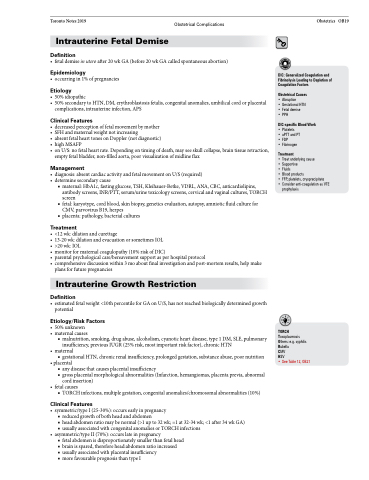Page 859 - TNFlipTest
P. 859
Toronto Notes 2019 Obstetrical Complications Intrauterine Fetal Demise
Definition
• fetaldemiseinuteroafter20wkGA(before20wkGAcalledspontaneousabortion) Epidemiology
• occurringin1%ofpregnancies
Etiology
• 50%idiopathic
• 50%secondarytoHTN,DM,erythroblastosisfetalis,congenitalanomalies,umbilicalcordorplacental
complications, intrauterine infection, APS
Clinical Features
• decreasedperceptionoffetalmovementbymother • SFHandmaternalweightnotincreasing
• absent fetal heart tones on Doppler (not diagnostic) • high MSAFP
• onU/S:nofetalheartrate.Dependingontimingofdeath,mayseeskullcollapse,braintissueretraction, empty fetal bladder, non-filled aorta, poor visualization of midline flax
Management
• diagnosis:absentcardiacactivityandfetalmovementonU/S(required) • determinesecondarycause
■ maternal: HbA1c, fasting glucose, TSH, Kleihauer-Betke, VDRL, ANA, CBC, anticardiolipins, antibody screens, INR/PTT, serum/urine toxicology screens, cervical and vaginal cultures, TORCH screen
■ fetal: karyotype, cord blood, skin biopsy, genetics evaluation, autopsy, amniotic fluid culture for CMV, parvovirus B19, herpes
■ placenta: pathology, bacterial cultures
Treatment
• <12wk:dilationandcurettage
• 13-20wk:dilationandevacuationorsometimesIOL
• >20wk:IOL
• monitorformaternalcoagulopathy(10%riskofDIC)
• parentalpsychologicalcare/bereavementsupportasperhospitalprotocol
• comprehensivediscussionwithin3moaboutfinalinvestigationandpost-mortemresults,helpmake
plans for future pregnancies
Intrauterine Growth Restriction
Definition
• estimatedfetalweight<10thpercentileforGAonU/S,hasnotreachedbiologicallydeterminedgrowth potential
Etiology/Risk Factors
• 50%unknown • maternalcauses
■ malnutrition, smoking, drug abuse, alcoholism, cyanotic heart disease, type 1 DM, SLE, pulmonary insufficiency, previous IUGR (25% risk, most important risk factor), chronic HTN
• maternal
■ gestational HTN, chronic renal insufficiency, prolonged gestation, substance abuse, poor nutrition
• placental
■ any disease that causes placental insufficiency
■ gross placental morphological abnormalities (Infarction, hemangiomas, placenta previa, abnormal
cord insertion) • fetalcauses
■ TORCH infections, multiple gestation, congenital anomalies/chromosomal abnormalities (10%)
Clinical Features
• symmetric/typeI(25-30%):occursearlyinpregnancy
■ reduced growth of both head and abdomen
■ head:abdomen ratio may be normal (>1 up to 32 wk; =1 at 32-34 wk; <1 after 34 wk GA) ■ usually associated with congenital anomalies or TORCH infections
• asymmetric/typeII(70%):occurslateinpregnancy
■ fetal abdomen is disproportionately smaller than fetal head ■ brain is spared, therefore head:abdomen ratio increased
■ usually associated with placental insufficiency
■ more favourable prognosis than type I
Obstetrics OB19
DIC: Generalized Coagulation and Fibrinolysis Leading to Depletion of Coagulation Factors
Obstetrical Causes
• Abruption
• Gestational HTN • Fetal demise
• PPH
DIC-specific Blood Work
• Platelets
• aPTT and PT • FDP
• Fibrinogen
Treatment
• Treat underlying cause • Supportive
• Fluids
• Blood products
• FFP, platelets, cryoprecipitate
• Consider anti-coagulation as VTE
prophylaxis
TORCH Toxoplasmosis Others: e.g. syphilis Rubella
CMV
HSV
• See Table 12, OB21


